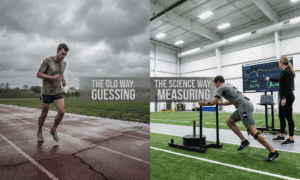When it comes to strength training, understanding the difference between one-repetition maximum (1RM) and personal record (PR) is crucial for setting goals, tracking progress, and optimizing performance. Both terms are often used interchangeably, but they have distinct meanings and implications. This article will delve into these differences, provide examples, and explain how tools like the 1RM calculator, 1RM calc, and e1RM calculator can help you to estimate 1RM and track your PR effectively.
DOWNLOAD SPLEEFT APP NOW FOR PHONE, MAC AND WATCH!
Understanding 1RM vs. PR
Understanding 1RM

1RM stands for one-repetition maximum, which is the maximum amount of weight a person can lift for one complete repetition of a given exercise. It is a benchmark used to measure an individual’s maximal strength for that particular exercise.
Calculation Methods:
- Direct Testing: The most accurate method involves performing a lift with increasing weights until the maximum lift with proper form is determined. However, this method can be risky and may lead to injuries if not performed correctly.
- Estimation Methods: To avoid the risks associated with direct testing, various estimation methods can be used. These include:
- Epley Formula: 1RM = Weight * (1 + 0.0333 * Reps)
- Brzycki Formula: 1RM = Weight * (36 / (37 – Reps))
- 1RM Calculator Tools: Online tools like the e1RM calculator provide a user-friendly way to estimate your 1RM based on submaximal lifts.
Understanding PR
PR stands for personal record, which refers to the heaviest weight an individual has ever lifted for a specific exercise. Unlike 1RM, a PR is not necessarily the maximum weight that can be lifted in a single repetition; it can refer to the best performance in various contexts, such as the highest weight lifted for a certain number of repetitions.
Types of PRs:
- Single-Rep PR: The heaviest weight lifted for one repetition.
- Multi-Rep PR: The heaviest weight lifted for a specified number of repetitions (e.g., 5RM, 10RM).
Key Differences Between 1RM and PR
- Definition:
- 1RM: Theoretical or directly tested maximum weight for one rep.
- PR: Actual highest weight lifted for one or more reps during any workout session.
- Measurement:
- 1RM: Often estimated using formulas or direct testing.
- PR: Recorded during training sessions or competitions.
- Context:
- 1RM: Used primarily to gauge maximum strength and set training loads.
- PR: Used to track progress and achievements over time.
- Risk:
- 1RM: Higher risk if tested directly due to the heavy load.
- PR: Lower risk as it can be set with different rep ranges and during normal training.
Examples and Scenarios
Scenario 1: Bench Press
- 1RM Calculation: John estimates his 1RM for the bench press using the Epley formula. He lifts 100 kg for 5 reps. Using the formula, his estimated 1RM is 116.65 kg.
- PR Achievement: During a training session, John lifts 105 kg for one rep, setting a new single-rep PR.
Scenario 2: Squat
- 1RM Direct Testing: Jane attempts a 1RM squat and successfully lifts 120 kg.
- Multi-Rep PR: In another session, Jane squats 100 kg for 8 reps, setting an 8RM PR.
Tools to Estimate 1RM

Using tools like the 1RM calculator, 1RM calc, and e1RM calculator can help in estimating your 1RM safely. These tools use various formulas to predict your 1RM based on lighter weights and higher repetitions. They provide an easy and risk-free method to gauge your maximum strength without attempting maximal lifts directly.
Additionally, Spleeft App offers an advanced method to estimate your 1RM by utilizing velocity-based training data. Spleeft measures barbell velocity and jump height in real-time using just your phone or Apple Watch. By analyzing your performance data, Spleeft can accurately estimate your 1RM, helping you set appropriate training loads and monitor progress.
Benefits of Using Spleeft:
- Real-Time Analysis: Get immediate feedback on your lifts.
- Accurate Estimation: Utilizes advanced algorithms to predict 1RM based on your velocity data.
- Convenient and Safe: Avoids the risks associated with direct 1RM testing.
The Role of Velocity Based Training

Velocity-based training (VBT) is a modern approach that involves measuring the speed of lifts to optimize training intensity and volume. VBT can provide insights into an athlete’s readiness and help in adjusting loads to match daily performance levels.
Benefits of VBT:
- Precision: Adjusts loads based on real-time performance.
- Safety: Reduces the risk of overtraining and injuries.
- Efficiency: Enhances training outcomes by optimizing effort.
Using a e1RM Calculator and PR to Set Goals
Both 1RM and PR are essential for setting realistic and progressive training goals. They help in:
- Benchmarking Strength: Establishes a baseline to measure progress.
- Programming: Informs training loads and intensities.
- Motivation: Provides clear targets to achieve.
Example Goal Setting:
- Short-Term Goal: Increase squat 1RM by 5 kg in three months.
- Long-Term Goal: Achieve a 150 kg deadlift PR by the end of the year.
Common Mistakes and How to Avoid Them When Using a 1rm Calculator
- Overestimating 1RM: Avoid using overly optimistic estimates. Use conservative formulas and retest periodically.
- Ignoring PRs: Track PRs for various rep ranges, not just single reps. It provides a comprehensive view of strength improvements.
- Neglecting Recovery: Ensure adequate rest and recovery between heavy lifting sessions to prevent injuries and promote strength gains.
Conclusion
Understanding the difference between 1RM and PR is vital for effective strength training. While 1RM provides a measure of maximal strength, PR tracks personal achievements across different contexts. Utilizing tools like the 1RM calculator, Spleeft app, and incorporating velocity-based training can enhance your training efficiency and safety. By setting clear goals and avoiding common mistakes, you can optimize your strength training program and achieve significant progress.
Whether you are a novice lifter or an experienced athlete, keeping track of your 1RM and PR, using estimation tools, and applying velocity-based training principles can lead to better performance and consistent strength gains.





